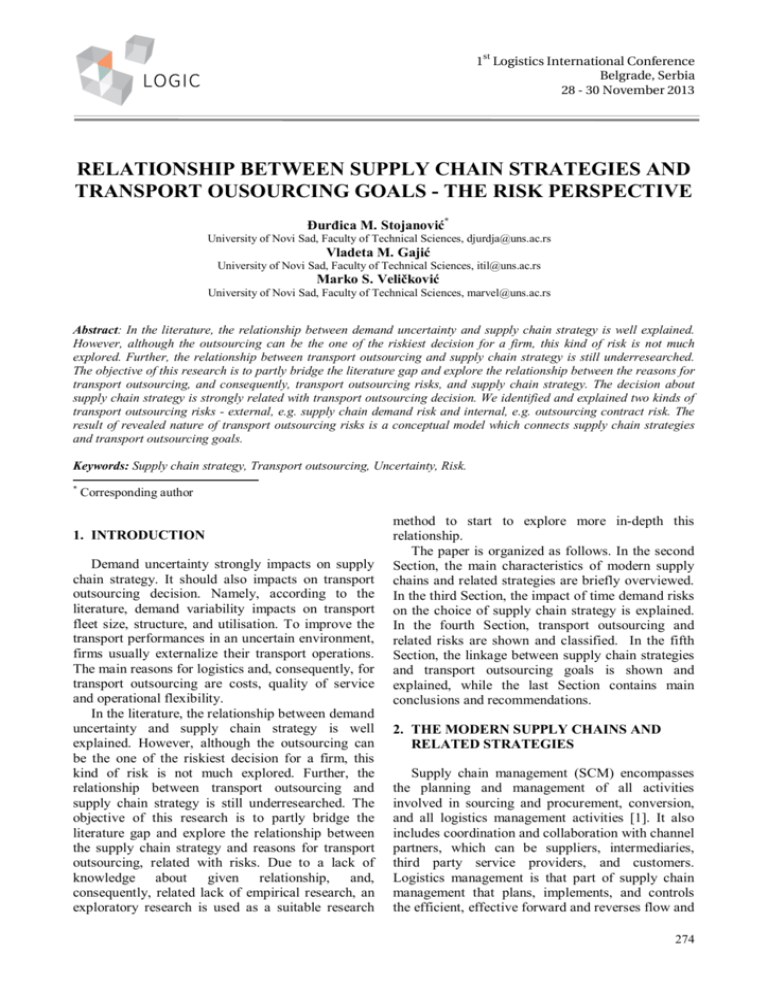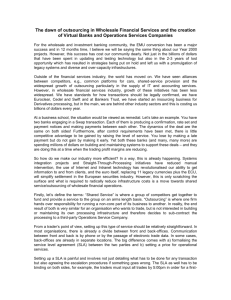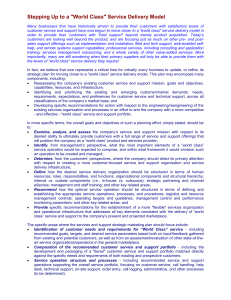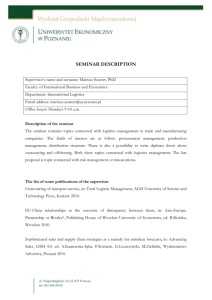
st
1 Logistics International Conference
Belgrade, Serbia
28 - 30 November 2013
RELATIONSHIP BETWEEN SUPPLY CHAIN STRATEGIES AND
TRANSPORT OUSOURCING GOALS - THE RISK PERSPECTIVE
Đurđica M. Stojanović*
University of Novi Sad, Faculty of Technical Sciences, djurdja@uns.ac.rs
Vladeta M. Gajić
University of Novi Sad, Faculty of Technical Sciences, itil@uns.ac.rs
Marko S. Veličković
University of Novi Sad, Faculty of Technical Sciences, marvel@uns.ac.rs
Abstract: In the literature, the relationship between demand uncertainty and supply chain strategy is well explained.
However, although the outsourcing can be the one of the riskiest decision for a firm, this kind of risk is not much
explored. Further, the relationship between transport outsourcing and supply chain strategy is still underresearched.
The objective of this research is to partly bridge the literature gap and explore the relationship between the reasons for
transport outsourcing, and consequently, transport outsourcing risks, and supply chain strategy. The decision about
supply chain strategy is strongly related with transport outsourcing decision. We identified and explained two kinds of
transport outsourcing risks - external, e.g. supply chain demand risk and internal, e.g. outsourcing contract risk. The
result of revealed nature of transport outsourcing risks is a conceptual model which connects supply chain strategies
and transport outsourcing goals.
Keywords: Supply chain strategy, Transport outsourcing, Uncertainty, Risk.
*
Corresponding author
1. INTRODUCTION
Demand uncertainty strongly impacts on supply
chain strategy. It should also impacts on transport
outsourcing decision. Namely, according to the
literature, demand variability impacts on transport
fleet size, structure, and utilisation. To improve the
transport performances in an uncertain environment,
firms usually externalize their transport operations.
The main reasons for logistics and, consequently, for
transport outsourcing are costs, quality of service
and operational flexibility.
In the literature, the relationship between demand
uncertainty and supply chain strategy is well
explained. However, although the outsourcing can
be the one of the riskiest decision for a firm, this
kind of risk is not much explored. Further, the
relationship between transport outsourcing and
supply chain strategy is still underresearched. The
objective of this research is to partly bridge the
literature gap and explore the relationship between
the supply chain strategy and reasons for transport
outsourcing, related with risks. Due to a lack of
knowledge about given relationship, and,
consequently, related lack of empirical research, an
exploratory research is used as a suitable research
method to start to explore more in-depth this
relationship.
The paper is organized as follows. In the second
Section, the main characteristics of modern supply
chains and related strategies are briefly overviewed.
In the third Section, the impact of time demand risks
on the choice of supply chain strategy is explained.
In the fourth Section, transport outsourcing and
related risks are shown and classified. In the fifth
Section, the linkage between supply chain strategies
and transport outsourcing goals is shown and
explained, while the last Section contains main
conclusions and recommendations.
2. THE MODERN SUPPLY CHAINS AND
RELATED STRATEGIES
Supply chain management (SCM) encompasses
the planning and management of all activities
involved in sourcing and procurement, conversion,
and all logistics management activities [1]. It also
includes coordination and collaboration with channel
partners, which can be suppliers, intermediaries,
third party service providers, and customers.
Logistics management is that part of supply chain
management that plans, implements, and controls
the efficient, effective forward and reverses flow and
274
st
1 Logistics International Conference, Belgrade, Serbia, 28 - 30 November 2013
storage of goods, services and related information
between the point of origin and the point of
consumption in order to meet customers'
requirements. It is an integrating function, which
coordinates and optimizes all logistics activities, as
well as integrates logistics activities with other
functions including marketing, sales manufacturing,
finance, and information technology.
Some important characteristics of modern supply
chains are emphasized in [2]:
There is no more competition between
companies within the supply chain, but
between different supply chains;
The biggest opportunity for costs reduction
and/or value increasing lies in partners
connection in supply chains;
The competitiveness of the supply chain is
based on the added value achieved by
information exchange;
Competitiveness of supply chains requires
joint
determination
of
management
strategies
etc.
Appropriate
strategy
of
supply
chain
management relies on several key factors [3]:
Strategy should be adapted to specific
requirements of customers;
Products flow management with stable
requirements and reliable supply sources
should not be the same as the flows
management where the demand is uncertain
and source of supply is unreliable;
The Internet can be a powerful tool for
enabling, or supporting the development of
specific strategies for supply chain
management;
Management strategies based on the
reasoning "the same rule for all" will fail.
A key objective in supply chain management is
to shape a chain to meet customer needs and create
added value according to given constraints, and
among the main constraints is supply chain
uncertainty. For these reasons, academics have
begun to identify the characteristics of supply
chains, to get the better insight into their nature. Two
main groups of characteristics determine the nature
of supply chain [3] - characteristics of supply and
characteristics of demand. Regarding to both of
them, stable and evolving, functional and innovative
supply chains are identified.
Regarding to the new approach to the supply
chain and supply chain management, a literature
began to identify and analyze the various supply
chain strategies, mostly during the nineties. The two
basic types of strategies are: effective and responsive
chains; and the lean and agile chains. Even in the
most recent literature, one can notice a little
confusion regarding the usage of these terms, and
the fact that some authors do not clearly distinguish
these two classifications (see also [4]).
3. THE RELATIONSHIP BETWEEN TIME
DEMAND RISKS AND SUPPLY CHAIN
STRATEGIES
The uncertainty and risks can occur at any point
and in any relationship in global supply chains [5].
Therefore, the size and complexity of the supply
chains certainly affect the risk increase. The
production and/or logistics in global supply chains
are often outsourced, which brings many
opportunities; it reduces the influence of the demand
uncertainty and fixed capital, and supports
expansion into new markets. However, outsourcing
increases the complexity of the supply chain,
because outsourced processes and new participants
can be difficult to control, especially in the unknown
markets.
Interorganizational networking and, particularly,
partnerships with small and medium-sized
enterprises (SMEs), increase exposure to risk in
large companies [6]. In contrast, SMEs also have
their own business risks because of the stronger
links with partners in the supply chain (ibid.).
The literature body about logistics risks in supply
chain is scarce, compared with the one about other
supply chain risks [7]. Some authors divide logistic
risks, associated with the dynamic characteristics of
the supply chain demands, on the risks related with
the supply uncertainty and risks related with the
demand uncertainty [3]. Consequently, four different
types of supply chains were identified: efficient,
risk-hedging, responsive and agile supply chains
(Table 1).
Efficient supply chains use strategies and
concepts to minimize activities that do not add value
to the product, while using economies of scale and
optimization techniques and methods in order to
maximize capacity utilization in production and
distribution. Developed database and information
flows are also used for the same purpose, while the
Internet can be a convenient way to achieve
integration of information flows. Optimization of
production and distribution in this case is performed
on the basis of transparent data for demands,
capacities and inventories along the supply chain.
275
st
1 Logistics International Conference, Belgrade, Serbia, 28 - 30 November 2013
Table 1. Supply chain management strategies
classified according to the degree of uncertainty of the
processes and customers demand [3]
Demand uncertainty (customers)
Low
(Stable
processes)
Efficient supply
chains
High
(Evolving
processes)
Supply uncertainty
(processes)
Low
(Functional
products)
Risk-hedging
supply chains
High
(Innovative
products)
Responsive
supply chains
Agile supply
chains
Risk-hedging supply chains use strategies and
concepts in order to reduce risk to the individual
actors. These strategies tend to pull and share
resources in chains so that the risks are also shared
in case of disruption. Individual participants in the
chain can be sensitive to a disruption in supply, but
in cases with more than one source of supply, or
when there are alternative suppliers, the risk of the
disturbance can be reduced. Increasing the level of
minimum inventory and sharing the related holding
inventory costs with other participants who are also
interested to prevent delays in delivery, are the ways
to deal with a variety of companies risk management
in supply chain. Information technologies, especially
the Internet, have a crucial role in ensuring data
transparency between companies that share this type
of risk. Information on real-time inventory allows
the goods movement from one point to another with
minimum costs.
Responsive supply chains use strategies that
increase the reaction time and flexibility of variable
and specific needs of customers. The Internet
primarily enables defining the exact individual
wishes of customers and meeting their requirements
in the shortest possible time. One way to achieve
this is online ordering, which provides access to the
customers and allows 24 hours service seven days a
week, as well as the rapid transfer of informations
between all stakeholders in the supply chain
involved in making product (eg. assembling of
ordered computer configuration).
Agile supply chains use strategies that aim to be
responsive and flexible to the needs of customers,
while sharing the risk among all subjects. They
actually combine the positive characteristics of
responsive supply chains and risk-hedging supply
chains. This type is known as agile because they
have the ability to respond quickly to changes,
diversification
and
unforeseen
customer
requirements, while minimizing the risk associated
with fluctuations in various demands, incurred by
individual actors in the supply chain.
The interest for risks related with particular
supply chains are rapidly rising among researchers
(see, for example [8]).
4. MAIN RISKS IN TRANSPORT
OUTSOURCING
Although outsourcing may represent the one of
the riskiest decision for the company, the literature
rarely discusses this type of risk and its reducing
potentials [9, 10]. Therefore, modern supply chains
are becoming more risky, due to a higher number
and
complexity
of relationships
between
participants, which may be disrupted or interrupted
for a variety of reasons. Along with several other
dominant trends in business, the trend of
outsourcing, including logistics outsourcing, resulted
in gradual development of increasingly complex
networks and supply chains [11]. Supply chains
grow in length and/or width and a large number of
companies are involved in more than one supply
chain, thus connecting the supply chains in larger
and more complex network structures.
Transport is a function that moves goods from
one point to another and so temporally and spatially
connecting the different entities in the supply chain.
Transport costs can be very significant in the overall
cost of the product. For example, the cost of freight
transport is equivalent to 6% of gross domestic
product in the United States [12]. The importance of
transport function is also shown as average transport
cost per unit of product. Transport costs account for
about 3% of the product price on average [13]. The
development of electronic commerce, associated
reduction in the average size of shipments and an
increase in average number of door to door
deliveries, increases the importance of transport
costs.
For the purpose of this research, from the
viewpoint of transport managers – decision-makers,
all transport risks in supply chains are classified as
internal and external risks. The internal, or inner
risks include all risks related to transport outsourcing
decision making: owning own-account fleet,
choosing the number of carriers, outsourcing of
particular or full management activities, etc.
Therefore, internal risks are connected with the
relationship carrier-customer of transport services,
whereby it sometimes could be the same business
entity. The transport service customer usually bears
the main risk pressure and responsibility for
miscalculations, since he pays for a service, has a
276
st
1 Logistics International Conference, Belgrade, Serbia, 28 - 30 November 2013
5. THE LINKAGE BETWEEN SUPPLY
CHAIN STRATEGIES AND TRANSPORT
OUSOURCING GOALS
According to their discussed characteristics, the
supply chain strategies can be now interrelated with
the main goals of transport outsourcing, in
accordance with the related risk classification.
Again, the main objectives of transport outsourcing
in the literature are costs minimization, increase of
transport services quality and adaptation of the
company's business strategy. However, there is no
available literature that clarify what it means to
"adjust the business strategy of the company." Also,
there is no available literature that clearly link
concepts and management strategies with the
outsourcing decisions, and there is no technique, or
method of decision making where a particular
management strategies are clearly linked to the
appropriate outsourcing concepts.
The lack of literature dealing with analysed
problem is also identified in [14], where it is
emphasized that connection between the strategy of
supply chain management and logistics outsourcing
is not sufficiently researched.
The main reasons/goals for transport outsourcing
are identified in Table 2 and assigned to specific
supply chain management strategies. They are in
accordance with the goals identified in [10].
The proposed model deals with the combination
of uncertainty and, consequently risks related to the
outsourcing of transport operations and risks in
products supply and demand (Table 1). The degree
of uncertainty can be related to the complexity of the
process, the state of the transport market and the
ability to manage and control outsourced processes.
Table 2: Linking SCM strategies with the primary
goals of transport outsourcing (TO) by using the risk
perspective
Low
efficiency
1. goal: minimization of
logistics (transport) costs
responsiveness
3. goal: minimization of
delivery times
High
(Transport) demand risks
Low
High
(functional products)
(innovative products)
Transport outsourcing risks
high influence on the usage of available transport
resources and directly benefit from the the high
quality of transport services.
The external, or outer risks associated with the
decision on transport outsourcing include risks
related to the dynamic characteristics of the
requirements described in the previous section. They
may be implied by changing end-user demands,
expanding markets or changing the distribution
network, by changing the number of participants in
the supply chain, the types of relationships between
entities, etc.
The risk related to the dynamic characteristics of
the supply chain can be reduced by transferring the
risk to the logistics/transport provider, or
outsourcing. This increases companies flexibility,
i.e. reaction time to changing market demands.
However, the experiences of the outsourcing
decision-making indicate that outsourcing of costs
and risks often outsource a competencies and
process manageability. Increased risk on opportunity
is possible if the company does not manage the
outsourcing processes and has not developed
mechanisms for decision making on such an
important issue [10].
risk-hedging
2. goal: minimization of
internal TO risks
agility
4. goal: Flexibility,
minimization of total
external and internal
TO risks
The presented results could be inspirative for
further research about the impact of supply chain
strategy on transport outsourcing decision-making.
They open the room for both, exploratory and
explanatory research in the future and contribute to
the normative body of literature on transport
outsourcing, which is, actually, scarce.
The proposed model also has a practical value. It
could help transport managers in decision-making to
identify the best transport insourcing/outsourcing
concept for particular supply chain strategy. For that
purpose, the proposed model should be used in the
very first steps of outsourcing decision-making
procedure.
6. CONCLUSION
Supply chains are dynamic in their nature, and
processes are managed with a smaller or larger
degree of uncertainty and risks, which affects the
variability and uncertainty of a need for transport
services.
Transport outsourcing does not reduce the risks
associated with the negative impact of dynamic
characteristics of supply chains on transport
performance (here: external outsourcing risks), but it
can transfer them from transport service customer to
the carrier. Moreover, one of the major reasons for
popularity of transport outsourcing may be pushing a
part of supply chain risks from transport service
customer to transport service provider. Actually, a
need to minimize risk in such way is often in behind
277
st
1 Logistics International Conference, Belgrade, Serbia, 28 - 30 November 2013
the term “flexibility”, one of the most cited reasons
for outsourcing. Virtually, outsourcing reduces risk
and increases flexibility of the company expressed in
the response time to unknown conditions. However,
the introduction of new entities and relationships
always brings new risks in the supply chain. It is
proposed a conceptual model, that consider both
types of risks and they are connected with transport
outsourcing goals. The important implication of this
research is that a decision on transport outsourcing,
from the risk perspective, should be made by taking
into account both types of risks. The proposed model
contributes to the normative research on outsourcing
decision-making procedure, because it connects the
supply chain management strategy with the transport
outsourcing goals from the supply chain and
outsourcing risk perspective.
ACKNOWLEDGMENT
This paper was realized as a part of the projects
(36030) financed by the Ministry of Education and
Science of the Republic of Serbia for the period
2011-2014.
REFERENCES
[1] The Council of Supply Chain Management
Professionals (CSCMP), 2013. Supply Chain
Management Definitions, [Online], Available from:
http://cscmp.org/about-us/supply-chain-managementdefinitions, [Accessed 10 September 2013].
[2] Hines, P., 2003. Future trends in supply chain
management, in: Waters, D. (ed.), Global Logistics
and Distribution Planning, London, Kogan Page.
[3] Lee, H.J., 2002. Aligning Supply Chain Strategies with
Product Uncertainties, California Management
Review, Vol. 44, No. 3 Spring 2002, pp. 105-119.
[4] Gillyard, A.E., 2003. The Relationships Among Supply
Chain Characteristics, Logistics and Manufacturing
Strategies and Performance, Dissertation presented in
Partial Fulfillment for the Degree Doctor of
Philosophy, the Ohio State University.
[5] Li, J. and Hong, S., 2006. A New Model Of Supply
Chain Risk Management: CFPM, 4th International
Conference on Supply Chain and Information Systems
SCMIS 2006 - Book of Proceedings, pp. 775-783,
Institute of E-Commerce, National Chung Hsing
University, Taiwan.
[6] Finch, P., 2004. Supply chain risk management.
Supply Chain Management, Vol. 9, No. 2, pp. 183-96.
[7] Maslarić, M., Huiskonen, J., Groznik, A. and
Bačkalić, T., 2012. Supply Chain Risk Management:
Literature Review with Risk Categorization and
Papers Classification, In: Kersten, W., Blecker, T.
and Ringle, C.M. (Eds.): Managing the Future Supply
Chain, Current Concepts and Sollutions for Reliability
and Robustness, Band 9, EUL Verlag, pp. 101-116.
[8] Kersten, W. and Wente, I.M., 2012. Reactive versus
Proactive Supply Chain Risk Management – An
Exploratory Study in the Automotive Industry, In:
Kersten, W., Blecker, T. and Ringle, C.M. (Eds.):
Managing the Future Supply Chain, Current Concepts
and Sollutions for Reliability and Robustness, Band 9,
EUL Verlag, pp. 87-100.
[9] Berger, P.D., Gerstenfeld, A., Zeng, A.Z., 2005. The
optimal use of standby suppliers: A decision-analysis
approach, International Journal of Logistics: Research
and Applications, Vol. 8, No. 1, pp. 67–79.
[10] Cakić, Dj., 2009. Oblikovanje transportnih resursa
u lancima snabdevanja, PhD Dissertation, University
of Novi Sad, Faculty of Technical Sciences, Novi Sad.
(In Serbian).
[11] Harland, C., Brenchley and R. Walker, H., 2003.
Risk in supply networks, Journal of Purchasing
&Supply Management, No. 9, pp. 51 –62.
[12] Chopra, S. and Meindl, P., 2004. Supply Chain
Management, Strategy, Planning and Operations, 2nd
edition, Pearson Prentice Hall, p. 413.
[13] Rushton, A., Oxley, J. and Croucher, P., 2000. The
Handbook of Logistics and Distribution Management,
Kogan Page Limited, London, UK.
[14] McKinnon, A., 2003. Outsourcing the logistics
function, in Waters, D. (ed.), Global Logistics and
Distribution Planning, London, Kogan Page
278









